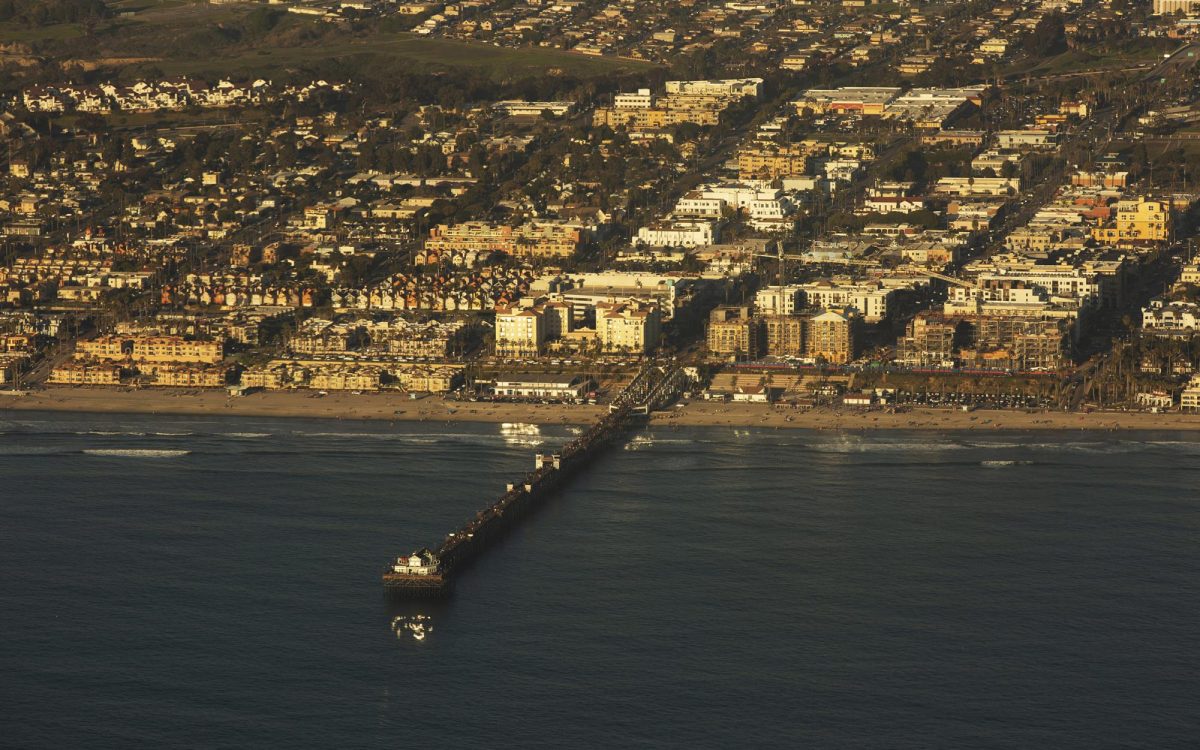Political and environmental observers in Oceanside appear likely to keep a cautious eye on the city’s recently approved RE:BEACH sand retention project, based on comments to the City Council ahead of its green light.
To applause and an outpouring of supportive community comments, the City Council unanimously approved a RE:BEACH contract with International Coastal Management on Wednesday, Jan. 31, after a design competition that drew international attention.
Australia-based ICM won over the project selection panel, and ultimately the City Council, with its “living speed bumps” design, which would involve constructing small headlands and an offshore artificial reef to help maintain back beach sand and sandbars. ICM has used the design along Australia’s Gold Coast.
 “ICM’s idea, the ‘Living Speed Bumps,’ taps into their experience along Australia’s Gold Coast,” Jayme Timberlake, Oceanside’s coastal zone administrator, noted in a city news release. “By piloting this project, the City is taking proactive measures to responsibly address both chronic coastal erosion and sea level rise stressors along our shoreline, while adding another coastal management tool to the toolbox.”
“ICM’s idea, the ‘Living Speed Bumps,’ taps into their experience along Australia’s Gold Coast,” Jayme Timberlake, Oceanside’s coastal zone administrator, noted in a city news release. “By piloting this project, the City is taking proactive measures to responsibly address both chronic coastal erosion and sea level rise stressors along our shoreline, while adding another coastal management tool to the toolbox.”
The RE:BEACH competition was launched in 2023 with an international call to landscape architecture and coastal engineering firms to submit proposals. From six submissions, the RE:BEACH project panel chose three finalists: ICM, Deltares/MVRDV and SCAPE/ESA. The teams collected hundreds of comments from residents and community groups through a series of public workshops. By the start of 2024, the project panel settled on ICM’s design.
“We want to protect and restore our beaches and coastal habitat”, Bob Ashton, Save Oceanside Sand CEO and RE:BEACH jury member, said in the city’s news release. “At our core, Oceanside is a beach town. Our beach is the life-blood of our city, recreation, relaxation and economic resilience are all key drivers and preserving sandy beaches should be a top priority, and I am thrilled that the council took action to unanimously support this.”
With the City Council’s approval, an analysis will now be done to determine where the pilot project could be located within three segments south of Oceanside Pier. Results are slated to be presented at a public workshop by sometime this summer. The City Council would then consider approval of the location at an additional workshop by the fall.
It will take about two years to handle engineering plans, environmental reviews and permits, according to the city.
 “The goal is to get a shovel-ready project in early 2026,” Brian Leslie, senior coastal scientist with environmental consulting firm GHD, told the City Council on Jan. 31.
“The goal is to get a shovel-ready project in early 2026,” Brian Leslie, senior coastal scientist with environmental consulting firm GHD, told the City Council on Jan. 31.
Construction of the pilot project is estimated to cost between $30 million to $50 million, Leslie said.
GHD will continue to serve as the project’s prime consultant working with ICM and the city.
“This opportunity perfectly aligns with our deep passion for impactful projects, and we are confident that Oceanside will emerge as a shining example of coastal resilience in California,” Aaron Salyer, ICM’s principal engineer and director, said in the city’s news release. “Our commitment extends beyond design; we eagerly anticipate contributing our extensive expertise in implementation, monitoring, and management of dynamic coastal environments to ensure the success of this exciting project.”
Historic opportunity
Many residents and stakeholders present at the Jan. 31 City Council workshop expressed support of the initiative.
“You have before you much more than a vote tonight,” Lynn Abate-Johnson, an original volunteer with Save Oceanside Sand, told council members. “You have before you the opportunity, individually and collectively, to be heroes. And not only for the city of Oceanside, but for our sister cities, our neighboring cities all up and down the coast. … It’s an auspicious milestone in the history of Oceanside and, again, for the benefit of our neighboring cities.”
Abate-Johnson’s comments underscored earlier notes from Del Mar City Councilman Dwight Warden, who is chairman of the San Diego Association of Governments’ Shoreline Preservation Working Group and served on the RE:BEACH project selection panel. Encinitas City Councilwoman Joy Lyndes also served on the panel.
Warden said he had faith that the project would succeed for Oceanside, and that it could be applied “not only for Oceanside but for other places that are having similar problems.”
He also noted that although ICM’s design is experimental and hasn’t been tried on the U.S. West Coast, “it’s worked on the Gold Coast, so all the indications are it’s got a good chance of succeeding.”
The pilot project also has a failsafe where it can be removed if there is a problem, Warden said.
Fifth-generation Oceanside resident Louise Curcio recalled a time when the beaches were so wide that the bottoms of people’s feet could burn while walking out to the ocean.
“One of Oceanside’s best resources is the beach, and that’s why we’re here today. I wholeheartedly support the recommended pilot project proposed,” she told the council. “However, I urge you to think beyond the confines of this pilot project and to think big as you go into the next phase. … Think big, plan now, and anticipate how to scale the project to all Oceanside beaches.”
Eye on the surf
While the project has been lauded by experts as an innovative method to preserve and manage beach sand being lost to the effects of climate change, local up-river development and other urban impacts, the “living speed bumps” concept drew criticism from some in the Oceanside community, including Surfrider Foundation San Diego County, which had advisory representation on the selection panel.
Potential disruption to Oceanside’s surf was a common theme, including unintended consequences to the natural flow of sand along the coast.
“In Australia, they call these groynes. In Oceanside, they are being called speed bumps and artificial headlands, and they are one in the same: hard structures that stop the flow of sand,” Oceanside resident Carolyn Kramer told the City Council.
Kramer cited other issues contributing to sand erosion: the existence of Oceanside Harbor and sand mining up the San Luis Rey River, and the amount of riprap currently lining the Oceanside coastline.
“Put this all together and add sea level rise to the equation, and you have the recipe for our current beach conditions,” she said.
Kramer also brought up community resistance to groynes (also often spelled as groins) in Perth, Australia, over concerns that the hard structures could affect surf patterns. Residents and surfing advocates in the city of Joondalup, Australia, have been vocal about the groynes’ potential disruption to that region’s kitesurfing industry.
“The surf has been the best I have seen in years, and we can attribute it to our sand bars,” Kramer said on Jan. 31. “I have grave concerns about slowing down the swell and slowing down the sand movement as proposed in the project. With speed bumps and artificial reefs, this should have sent up a big red flag to every surfer who surfs our beach breaks. Anything that would slow down the swell, slow down the sand movement, is definitely not OK.”
Oceanside resident Mitch Silverstein, who is the policy coordinator for the Surfrider Foundation’s San Diego chapter and served as a nonvoting advisory member of the RE:BEACH design jury, gave a presentation to the City Council regarding the organization’s concerns.
While the RE:BEACH plan is progress, Silverstein said, the city should look at a broader approach to the problem of sand loss. The existence of Oceanside Harbor is one contributor to the problem, he noted, but there are other challenges to the city’s beaches that must be addressed.
“Development across the entirety of Oceanside’s historic back beach, from the Pier Plaza, which is city-owned, The Strand, which is city-owned; all the houses, those were all built on top of the beach; and we all need to have that reckoning and understand that,” he told the council. “If the city is not being forthcoming and communicating the entire spectrum of reasons why Oceanside beaches are disappearing, then how can we really trust the city to put forward an entire comprehensive set of solutions to what’s causing Oceanside’s beaches to disappear?”
Silverstein also reminded City Council members to consider that what’s done at one beach can affect another. The purpose of the reef proposal is sand retention, not surfing.
“The studies that we have on reefs all over the world is that you can’t have both,” he said. “You can’t have a sand retention reef and a surfing reef at the same time.”
Surf monitoring during the project’s implementation is extremely important, he said.
“Surfrider will not accept negative consequences to surf,” he told the council.
In addition to the RE:BEACH strategy, Surfrider made several suggestions, among them:
✔ Support restorations of coastal dunes and Loma Alta Creek.
✔ Renovate and reopen closed public beach access points.
✔ No new short-term rentals in the Coastal Zone (South Pacific Street).
✔ Enforce the city’s Local Coastal Program and current codes.
✔ Ensure that the Local Coastal Program Update includes new setbacks for beachfront properties.
✔ Create a resilient vision for The Strand and Pier area, starting with Tyson Street Dune Park, a proposal by SCAPE Landscape Architecture, one of the RE:BEACH finalists.
✔ Don’t give up on a fixed sand bypass/replenishment system.
“While Scape, one of the design competitors, did not win, the entire jury unanimously supported one of their ideas, called Tyson Street Dune Park,” Silverstein said.
The proposal would reroute The Strand toward the bluff and create 100 feet of beach width at a cost of about $13 million.
“This is something that the city of Oceanside with direction from council can start looking into today,” he said. “With all due respect to the ICM proposal, you don’t need a bunch of studies to figure out if this works or not. This is a slam dunk. You’ll gain a hundred feet of beach width exactly where the beach disappears in Oceanside.”
Silverstein said that the Surfrider Foundation looks forward to being a part of the RE:BEACH conversation, including the monitoring of the surf.
“We can’t afford to put all our eggs in the RE:BEACH basket,” he said.
Letters to the editor are welcome. Send letters to letters[at]northcoastcurrent.com.



